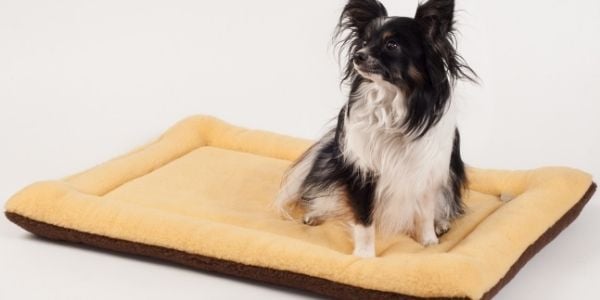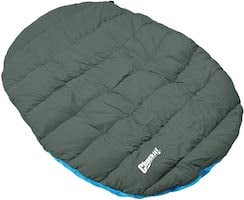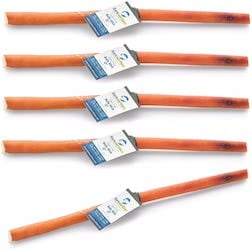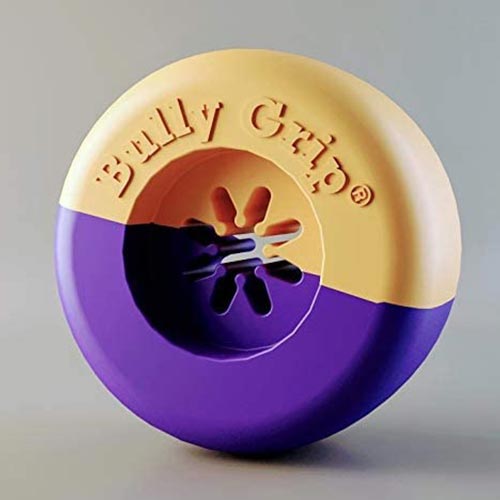 Being able to send your dog to a specific place, such as their bed or their dog mat, is one of the most useful things you can train.
Being able to send your dog to a specific place, such as their bed or their dog mat, is one of the most useful things you can train.
You may need your dog to stay out of the way while you're cooking, not beg at the table while you're eating, or, if you have visitors over and your dog is getting too excited, have them go settle at a distance.
The magic of the go to place cue is that you can even take it on the road!
You can take your dog's mat with you out and about to the coffee shop or outdoor dining, and have them settle at your feet.
I love having this cue as an option when teaching dogs how to settle around distractions, whether at training class, dog sport competitions, or just hanging out at the park and watching the world go by.
The go to place behavior is also an essential part of my resource guarding training plans, especially if I'm working with a dog who guards space. Being able to physically move your dog without having to touch them helps keep everyone safe in these situations.
What You'll Need
Choosing Your Dog's Place
Free Shaping the Go to Place
Luring the Go to Place
Reasons Your Dog May Not Go to Place
What You'll Need to Train Go to Place
Sit, Down, and Stay
It's easiest to introduce this new behavior to your dog after you've practiced sit, down, and stay. The go to place cue is chaining these behaviors together and linking them to a particular target where your dog performs them. These three cues don't need to be rock solid before starting to train go to place, but it's helpful if your dog is familiar with them.
Your Clicker or a Marker Word
We need to be able to tell a dog what it was that they got right clearly and precisely. You can use a clicker if you're familiar with one, but a marker word can work as well! I personally use the word "yes!" to mark the behavior that's getting rewarded. Some people may use a word like "click" or "yep." Read more about using a marker word in dog training here.
Training Treats Your Dog Loves (and Will Work For)
Good work deserves good payment! Have a treat pouch stocked with lots of your dog's favorite training treats ready for each practice session. My current treat rotation includes Ziwi Peak Air-Dried Dog Food (a great low-calorie and balanced nutritional option) and freeze-dried beef hearts from Stella & Chewy's (very high-value for most dogs).
Your dog determines what they find most valuable, and different dogs have different treat preferences. To figure out what your dog's favorite treats are, check out the tips in What Kind of Treats Should You Use to Train Your Dog.
Choose Your Dog's "Place"
Consistency is important with this cue, so pick a specific "place" and stick with it. If you've trained your dog that their place is their crate, but then ask them to go to place on a dog bed, they may get confused and not do what you've asked.

When using multiple place targets, the verbal cue you use can help make it clear to your dog where they are supposed to go. When I'm using my dog's mat, I say "go to bed" as a verbal cue. When using the raised platform, I use "place."
Do you want your dog's place to be portable? Use a dog mat, such as the Mutt Mat (what I use as a portable "place"), or a dog travel bed like the Chuckit! Travel Dog Bed, or a designated bath mat or yoga mat (cut to size).
You can certainly use your dog's crate as their place if you only plan on using this in your home or if you bring their crate with you while traveling. Or, if your dog has a favorite dog bed, you can make that their place.
PRO TIP: I've found that using a raised platform can help dogs learn this cue more quickly and be able to hold a stay longer. I use the Cato Board as my dog's platform place, but many of my clients will use a raised dog cot, like this one from Veehoo.
Training the Go to Place Cue: The Free Shaping Method
Step One: Introduce the Behavior
Stand or sit next to your dog's designated “place” with a clicker and lots of tiny high-value treats at the ready. Do not cue your dog to do anything; just wait.
Click or say "yes!" for any interaction with the place. For shy or timid dogs, just looking at the mat might be their first click opportunity. Click and treat for each look at the mat.
Pro Tip: To reset your dog’s position, toss the treat away from the place so they have to stand up and get off the mat to get it. This way you don’t have to lure your dog off the mat and you're ready for the next repetition.
In this short video, you can see this first step of my working with my dog Fozzie Bear. He has a positive history with free shaping, so he's very keen on offering behaviors and quickly learning what it was that got the click.
If your dog is new to free shaping or is cautious about new things, don't expect too much too soon. Go at your dog's pace.
Step Two: Work Up to the Whole Chain of Behavior
Once your dog is consistently looking at the mat in order to make you click, start upping the ante. Now click only if they touch the mat, whether with their nose or their paw. The first time they do this, give them a jackpot (a few treats given rapidly in succession) and praise!
Once they are consistently touching the mat, raise the criteria once more. First, it was just looking at the mat, second, it was touching it. Next, you might only click for two feet on the mat at a time, then up it to three, and eventually to all four. Wait until your dog is consistently offering the behavior before moving on.
Some dogs move through these steps quickly, while others need a bit more patience.
Up the difficulty level once again by adding the down-stay cue. You can go ahead and cue this if you need to, preferably with just a hand signal AFTER your dog has placed all four paws on the mat. Click and treat for the down-stay.
Practice this until your dog starts to offer the down-stay before you cue it. Their brain will be working hard to get you to click faster! You'll see Fozzie Bear working through this chain in this video, when I introduced a new place cue, "Frybread."
The video is time-lapsed to show you his first free shaping session with this new bed target, and within about 5 minutes total, I worked through steps one, two, and even started step three:
Step Three: Give It a Name
Add the verbal cue. Once your dog is offering the go to place chained with the down-stay (with no verbal cue for the down-stay), add in the new verbal cue “Go to Place.” Say this as they step onto the mat and lie down. Click and treat. Repeat, repeat, repeat!
Test their progress with this step by saying the verbal cue before they offer it. If they go to their spot and lie down, it's party time! Reward this with treats and praise. It means they've begun to learn the association between the sound of the cue and the behavior they are being asked to perform.
If they don't respond when hearing the verbal cue, that's okay! They just need more repetitions to build the association between the words and the behavior. You can help them by pointing at the place after giving the verbal cue to give them a clue. Then just keep practicing step three a bit longer.
Here's a video showing steps two and three in action with my dog Fozzie Bear. Notice how I say "place" as he's stepping onto the platform, but I don't click and treat until he's in the down position:
Step Four: Add in Distance & Duration
As you continue practicing this cue over multiple training sessions, start practicing sending your dog to their place from further away. You may want to work up to standing in the kitchen and sending your dog to their place across the room, or even in a different room!
Start easy when you add distance to the beginning of this behavior. During your initial training, you've been practicing right next to their place. As you increase the difficulty level now, give the verbal cue from one step away from the mat, bed, or crate.
If your dog seems confused, just step closer to the bed to give them a clue of what you're looking for with a hand pointing at the bed. Once they've got the idea at one step away, practice from two steps away, then three, and so on.
An important part of the behavior is being able to stay on their place for extended periods of time, so be sure to practice this part at the end of the go to place behavior. Again, start easy! Withhold the click or marker word until they've stayed in a down on their mat for 3 seconds, then work up to 5 seconds, then 10 seconds, and more.
Use Your Dog's Release Cue
As you can see in the video above, I start using Fozzie's release cue "okay" (meaning "you're all done, you can move"). Then I toss the treat off the platform. It's important to be clear with your dog when it is okay for them to break their stay with a cue that means they're all done. Common release cues include: okay, all done, freedom, free, etc.
It is always helpful in real life to have an enrichment toy (such as a stuffed Toppl or bully stick in a bully stick holder for safety) to give your dog something to do in their place while you enjoy company or eat dinner, etc. This way, they are kept busy and are being rewarded for staying in their place, without needing you to reward them with a treat intermittently.
For more tips on building up the duration of a stay, check out Teaching Your Dog to Stay.
Step Five: Keep Practicing and Fade Out Treats
After your dog is showing progress in responding to this cue from varying distances as well as longer stays on their place, start to fade out the clicker and treats.
Want to learn more about phasing out food treats in dog training? Read my article Be a Slot Machine: Fading Out Treat Rewards.
I love this video of free shaping a puppy that shows free shaping during regular day-to-day activities. I love free shaping when I'm working at my desk or relaxing on the couch. I always joke that free shaping is best when done with a glass of wine!
Take advantage of the power of free shaping to create a powerful routine for your dog by capturing their offered behaviors:
Teaching the Go to Place Cue with the Luring Method
Step One: Making the Behavior Happen
Hold a treat in your hand and place it in front of your dog's nose. Use their natural desire to follow the treat to guide them onto the place and into a down position on the place. When they settle into the down position, click (or say yes!) and give them a treat.
Repeat this step five to ten times to build a good foundation before trying it out without the treat in your hand. Your moving/pointing hand holding the food lure becomes your dog's hand signal for this cue. At first, the treat is making the behavior happen, but we want to move on to step two – where the behavior makes the treat happen – as quickly as possible. This is preventing you from bribing your dog.
Step Two: Fade Out the Treat Lure to Create a Hand Signal
Move your hand similarly towards the place for your dog as you were when you were holding the treat. For most people, this is usually pointing at the place. If your dog follows your hand signal and goes onto the mat and lies down, have a big party! Click and give them a few treats in a row to celebrate.
If they have a hard time following the hand prompt without the treat, that's okay. Go back to step one and repeat a few more times before trying without the treat in your hand.
Step Three: Put It on Cue
This is where we give the behavior a name. Before you give your dog the hand signal to go to their place, say the verbal cue "Go to Place." Then give the hand signal, click, and treat as you have been doing. Your dog needs a few repetitions of this to build the association that hearing "go to place" means to perform the behavior.
Say the verbal cue → Give the hand signal (point to place) → Click and Reward!
Test your dog's progress by saying "go to place" and waiting three seconds. If they don't begin to offer the behavior, they just need more repetitions.
Steps Four & Five: Keep Practicing
This part of the process is the same for both the free shaping technique above and the luring method. Focus on building up your dog's distance they must travel to their place and the duration of their stay on their place. Adding in distractions can also be helpful to make this a solid cue.
This video by Zak George shows the process of luring and hand signals to teach a dog to go to their place:
Reasons Your Dog May Not Go to Their Place When Asked
- Your dog may not understand the cue. Dogs learn by association, and it takes time to make associations! Make sure to practice lots of easy repetitions before moving to the next training step. If you need your dog to stay out from underfoot when you're cooking or having guests over, keep them in their crate, puppy playpen, or behind a gate or on a leash if needed. Management is training's best friend!
- Your dog is distracted. If there's lots going on in the environment, it can be incredibly hard for your dog to focus (or even hear you ask for a "go to place").
As you practice, work in distractions as your dog has to stay on their place. This could be you pretending to cook some dinner, or practicing on the mat outside in a yard, or at a park. Reward more frequently when distractions are present, to reinforce for your dog that staying on the mat pays better than chasing a squirrel. - Your dog doesn't want to work for what you're offering. Sometimes we fade out training treats too soon. Other times, your dog just isn't hungry, and treats have a lower value than, say, a game of tug or fetch.
You can incorporate toys as rewards for this training, just be aware that since it's supposed to be a settled and calm behavior all-around, you may not get as many repetitions in each training session as when you use treats. But it does create a great impulse control game for excitable and hyper dogs!
If your dog just isn't responding to the cue, even with tasty treats after lots of previous success, consider whether they're somehow stressed or overwhelmed with the environment or the training itself. Take a step back and try to figure out why your dog is having a tough time. For more tips and how-tos if your dog isn't going to place when asked, check out The Top 3 Reasons Your Dog Doesn't Do What You Want.







